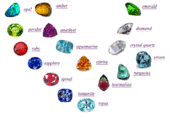Difference between revisions of "Gemstone"
| (3 intermediate revisions by the same user not shown) | |||
| Line 1: | Line 1: | ||
[[File:Precious-gemstone-names.gif|thumb|Cut Gemstones<br>Credit: Alvonzo Zone]] | [[File:Precious-gemstone-names.gif|thumb|Cut Gemstones<br>Credit: Alvonzo Zone]] | ||
== Description == | == Description == | ||
| − | [[File:gempebbles.jpg|thumb|Polished gemstones]] | + | [[File:gempebbles.jpg|thumb|Polished gemstones<br>Credit: Adrian Pingstone]] |
An ornamental, often valuable, mineral used for decoration in jewelry, small objects and clothing. Gems are found in alluvial deposits and dug from veins. Major mining locations include Sri Lanka, southeast Asia, South Africa, Australia, Russia, Brazil and Colombia. Gemstones are characterized based on their color, clarity, cut and weight. Stones of exceptional size, beauty or rarity are highly valued. Techniques for cutting and polishing gemstones were developed in India in the 14th century. Gemstones can usually be classified into three types: | An ornamental, often valuable, mineral used for decoration in jewelry, small objects and clothing. Gems are found in alluvial deposits and dug from veins. Major mining locations include Sri Lanka, southeast Asia, South Africa, Australia, Russia, Brazil and Colombia. Gemstones are characterized based on their color, clarity, cut and weight. Stones of exceptional size, beauty or rarity are highly valued. Techniques for cutting and polishing gemstones were developed in India in the 14th century. Gemstones can usually be classified into three types: | ||
| − | * Transparent crystalline stones; usually cut: [[amethyst]], [[diamond| | + | * Transparent crystalline stones; usually cut: [[amethyst]], [[aquamarine]], [[citrine]], [[emerald]], [[diamond|Diamonds]], [[garnet|Garnets]], [[peridot]], [[quartz]], [[ruby|Rubies]], [[sapphire|Sapphires]], [[spinel]], [[tanzanite]], [[topaz]], [[tourmaline]], and [[zircon]]. |
| − | * Non-transparent minerals, usually polished: [[agate]], [[ | + | * Non-transparent minerals, usually polished: [[agate]], [[carnelian]], [[cat's eye]], [[chrysoberyl]], [[chrysocolla]], [[jasper]], [[lapis lazuli]], and [[turquoise]] |
* Non-stone materials: [[ivory]], [[amber]], [[jet]], and [[coral]] | * Non-stone materials: [[ivory]], [[amber]], [[jet]], and [[coral]] | ||
Latest revision as of 12:55, 27 August 2022
Description
An ornamental, often valuable, mineral used for decoration in jewelry, small objects and clothing. Gems are found in alluvial deposits and dug from veins. Major mining locations include Sri Lanka, southeast Asia, South Africa, Australia, Russia, Brazil and Colombia. Gemstones are characterized based on their color, clarity, cut and weight. Stones of exceptional size, beauty or rarity are highly valued. Techniques for cutting and polishing gemstones were developed in India in the 14th century. Gemstones can usually be classified into three types:
- Transparent crystalline stones; usually cut: Amethyst, Aquamarine, Citrine, Emerald, Diamonds, Garnets, Peridot, Quartz, Rubies, Sapphires, Spinel, Tanzanite, Topaz, Tourmaline, and Zircon.
- Non-transparent minerals, usually polished: Agate, Carnelian, Cat's eye, Chrysoberyl, Chrysocolla, Jasper, Lapis lazuli, and Turquoise
- Non-stone materials: Ivory, Amber, Jet, and Coral
Synonyms and Related Terms
gemstones; gem; gem; ædelsten (Dan.); Schmucksteine (Deut.); gema (Esp.); gemme (Fr.); edelsteen (Ned.); gema (Port.); Ädelsten (Sven.)
Comparisons
Properties of Common Gemstones
Natural and Simulated Diamonds
Resources and Citations
- Encyclopedia Britannica, http://www.britannica.com Comment: "gemstone." Accessed 10 Nov. 2004 .
- C.W.Chesterman, K.E.Lowe, Audubon Society Field Guide to North American Rocks and Minerals, Alfred A. Knopf, New York, 1979
- The Dictionary of Art, Grove's Dictionaries Inc., New York, 1996 Comment: Gems: cutting. by Ken Scaratt
- Wikipedia: http://en.wikipedia.org/wiki/Gemstone (Accessed Nov. 2, 2005)


